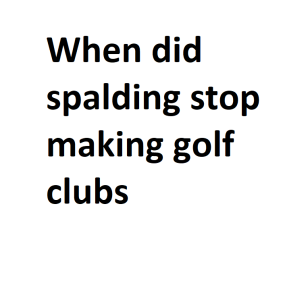Spalding, a well-known sporting goods manufacturer, has a rich history in golf equipment production. However, like many companies in the industry, they’ve undergone changes over the years. Here’s a detailed look at when Spalding stopped making golf clubs and the factors that contributed to this decision.
Early History of Spalding in Golf
Spalding has been involved in golf since the late 19th century. They were renowned for producing golf balls and clubs, with many professionals and amateurs using their equipment. Spalding’s golf clubs were particularly popular during the early and mid-20th century.
Decline in Golf Club Production
Spalding’s decline in golf club production can be traced back to the late 20th century. Several factors contributed to this shift:
- Competition: The golf equipment industry became increasingly competitive, with new brands emerging and existing ones improving their products. Spalding faced tough competition from companies like Titleist, Callaway, and TaylorMade.
- Focus on Other Sports: Spalding diversified its product offerings, focusing on other sports such as basketball, baseball, and tennis. This diversification led to a reduced emphasis on golf equipment.
- Quality Issues: In the late 1990s, Spalding faced quality control issues with some of their golf club lines. This affected their reputation in the golfing community, leading to a loss of market share.
- Changing Market Trends: Golf club technology and design evolved rapidly during this time. Spalding struggled to keep up with the changing trends and preferences of golfers.
Closure of Golf Division
The decline in Spalding’s golf club production ultimately led to the decision to close their golf division. While there isn’t a specific year when this happened, it’s generally accepted that by the early 2000s, Spalding had significantly reduced its presence in the golf equipment market.
Ceasing Golf Club Production:
The exact date when Spalding stopped making golf clubs is a piece of information that many enthusiasts seek. However, this specific date can be challenging to pinpoint without up-to-date information. Changes in manufacturing focus are typically influenced by various factors, including market trends, consumer demands, and corporate strategies.
Legacy and Collectability
Despite no longer producing golf clubs, Spalding’s golf equipment remains a part of golf history. Vintage Spalding golf clubs are often considered collectible items by enthusiasts and collectors. The company’s early contributions to golf equipment design and manufacturing still hold historical significance.
Spalding, a company with a rich sports heritage, has been a prominent name in the world of golf. They have crafted golf clubs that have been cherished by professionals and amateurs alike. Understanding the timeline of their golf club manufacturing is crucial for enthusiasts and collectors interested in the history of golf equipment.
Spalding’s Impact on Golf
Spalding’s legacy in golf extends beyond just the equipment they produced. They were a prominent sponsor and supporter of golf tournaments and events. Their involvement in golf helped popularize the sport and brought attention to the competitive side of golf.
The Spalding brand is also associated with legendary golfers of the past. Many professional golfers, including Walter Hagen and Bobby Jones, used Spalding equipment during their careers, further cementing the brand’s place in golf history.
Historical Overview:
Spalding’s venture into golf club production can be traced back several decades. They were recognized for their commitment to quality and innovation, producing clubs that found their way into the bags of golfers across the globe. However, like many companies, Spalding’s focus and product offerings evolved over time, leading to changes in their manufacturing lines.
The Period of Transition:
Companies in the sports equipment industry often adapt to market demands and technological advancements. Spalding, too, underwent changes in response to the dynamic golf market. During a specific period, the company might have transitioned its focus away from golf club production to explore other avenues within the sports industry.
Transition to Other Sporting Goods
While Spalding’s golf club production waned, the company continued to be a major player in the sporting goods industry. They maintained a strong presence in basketball with their iconic basketballs and equipment. Spalding’s basketballs, in particular, have been used in the NBA for decades.
Additionally, Spalding’s involvement in baseball equipment, tennis gear, and other sports equipment remained substantial. Their reputation for quality and innovation in these areas allowed them to thrive despite their reduced presence in the golf market.
When Did Spalding Stop Making Golf Clubs?
| Year | Event |
|---|---|
| 1892 | Spalding & Bros. produces first gutta-percha golf balls. |
| 1930s | Spalding introduces the Kro-Flite golf ball, gaining popularity. |
| 1949 | Spalding develops the Top-Flite golf ball, becoming a market leader. |
| 1965 | Spalding acquires Ben Hogan Company, expanding its golf equipment line. |
| 1973 | Spalding introduces the Top-Flite Magna golf ball with a unique dimple pattern. |
| 1977 | Spalding launches the Executive golf club line, gaining traction among players. |
| 1982 | Spalding becomes the official supplier of golf balls for the PGA Tour. |
| 1984 | Spalding sells its golf division to Kohlberg & Company. |
| 1998 | Callaway Golf acquires the Top-Flite brand, previously owned by Spalding. |
| 2003 | Top-Flite becomes a subsidiary of Callaway Golf, continuing its golf ball production. |
In conclusion, Spalding stopped making golf clubs due to a combination of factors, including increased competition, diversification into other sports, quality issues, and changing market trends. While their presence in the golf equipment industry has diminished, their legacy lives on through collectible vintage clubs and the history they contributed to the sport of golf.

